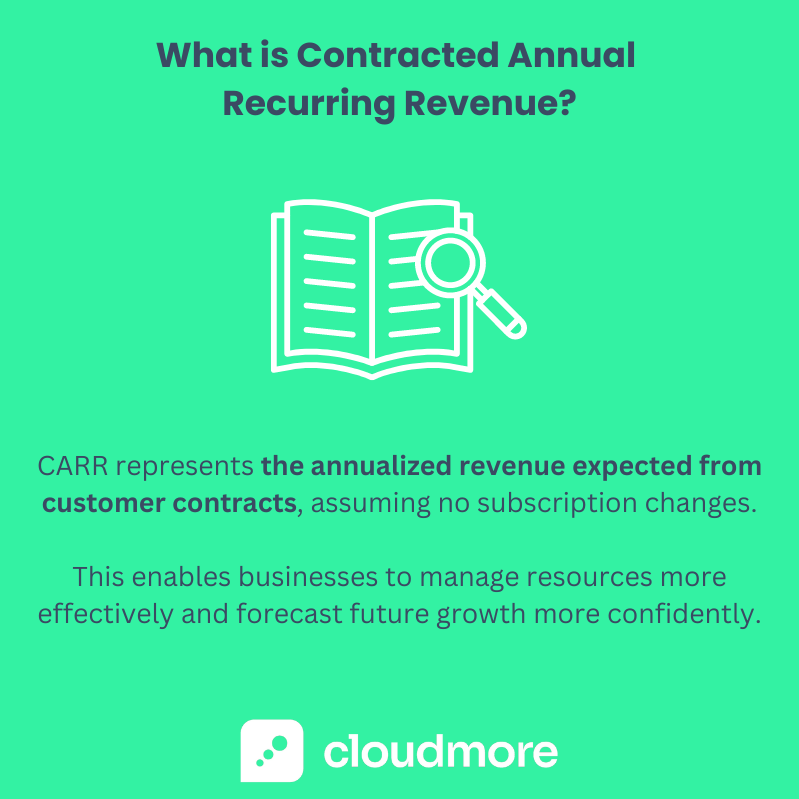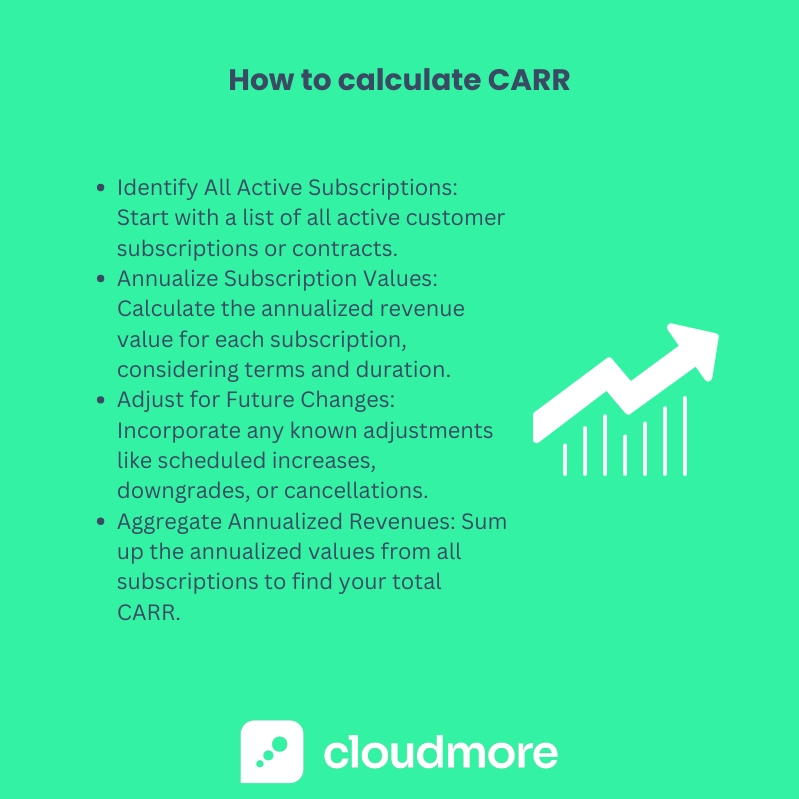Contracted Annual Recurring Revenue: Complete CARR Guide
Unlocking the full potential of your subscription-based business hinges on mastering a few critical metrics, with Contracted Annual Recurring Revenue (CARR) standing out as a cornerstone of financial insight and strategic planning.
This guide delves into the essence of CARR, revealing why it's not just another financial figure but a beacon guiding your business toward sustainable growth and success.
Whether you're steering a burgeoning SaaS venture or scaling a subscription service, understanding CARR's mechanics, implications, and strategic applications can transform how you view your company's financial landscape.
Understanding the Basics
In the dynamic landscape of subscription businesses, understanding the foundational metrics that gauge success is paramount.
Among these, contracted annual recurring revenue (CARR) is a cornerstone that guides strategic decisions and forecasting.
What is CARR?
Contracted Annual Recurring Revenue, or CARR, is a forward-looking metric crucial for subscription-based and software-as-a-service (SaaS) companies.
It represents the annualized revenue expected from customer contracts, assuming no changes in the subscription.
This metric is pivotal, not just for its immediate financial implications but also for its role in strategic planning and investor relations.

By providing a clear view of predictable revenue streams, CARR enables businesses to manage resources more effectively and forecast future growth more confidently.
CARR Meaning and Scope
Delving deeper into CARR's essence reveals its significance in business finance. This metric isn't merely a number—it's a lens through which companies can project their future financial health.
By encompassing all contracted revenue, CARR offers a comprehensive snapshot of a company's secured income, which is essential for long-term planning and operational stability.
Its scope extends beyond simple revenue tracking; it's a vital sign of a company's ability to sustain and expand its subscription model.
In this way, CARR becomes an indispensable tool for companies aiming to navigate the complexities of today's market dynamics, ensuring they survive and thrive by making informed decisions based on solid financial forecasting.
By understanding CARR fundamentals, businesses gain insights into their financial trajectory, enabling them to strategize precisely. This knowledge is not just power—it's the fuel for growth and sustainability in the competitive arena of subscription management.
CARR in Depth
Delving into the intricacies of Contracted Annual Recurring Revenue (CARR) unveils its pivotal role in shaping the success of modern businesses.
This section explores the mechanics behind CARR's calculation and its critical importance for SaaS and subscription-based business models.
CARR's Index and Calculation
Understanding how to calculate CARR is fundamental for any business that thrives on subscriptions or SaaS offerings.
At its core, CARR is determined by aggregating the annualized value of all active subscriptions or contracts at a given time. This includes adjustments for upgrades, downgrades, or cancellations expected within those contracts.
The formula to calculate CARR might seem straightforward, yet it demands meticulous attention to detail and accuracy in your subscription data management.
The role of CARR's index goes beyond a simple calculation; it serves as a crucial indicator of business performance.
By tracking changes in CARR over time, companies can glean insights into their growth trends, customer loyalty, and the effectiveness of their sales strategies.
It's a lens through which the financial trajectory of the business is viewed, offering a clear perspective on both strengths to be leveraged and areas needing improvement.
CARR Revenue: The Lifeline of SaaS Businesses
For SaaS and subscription-based enterprises, CARR revenue isn't just a metric—it's the lifeline that fuels their growth and sustainability.
This pivotal measure reflects the predictable income generated from your customer base, highlighting the importance of nurturing and expanding your subscribed clientele.
Businesses utilize CARR revenue data to help make decisions, from budget allocation to strategic planning. For example, a consistent increase in CARR might signal the right time for expansion or new product development. Conversely, a stagnant or declining CARR could prompt a reevaluation of marketing strategies or customer engagement practices.
Through real-world applications, such as optimizing pricing models or tailoring customer success initiatives, businesses can directly influence their CARR revenue, steering towards enhanced performance and profitability.
CARR's profound impact on SaaS and subscription models cannot be overstated. It offers a precise, quantifiable measure of recurring revenue that is essential for strategic decision-making, financial forecasting, and, ultimately, securing the business's long-term success.
Comparisons and Contrasts
Navigating the landscape of financial metrics in subscription-based businesses requires understanding the nuances between similar terms.
This section distinguishes between Contracted Annual Recurring Revenue (CARR) and Annual Recurring Revenue (ARR), two pivotal metrics that, while closely related, serve different purposes in financial analysis.
CARR vs ARR: Understanding the Differences
The distinction between CARR and ARR lies at the heart of financial planning and analysis for subscription-driven enterprises.
As previously defined, CARR forecasts the expected annual revenue from existing contracts, emphasizing the "contracted" or guaranteed nature of this income.
On the other hand, ARR represents the recurring revenue generated from customers over a year, assuming all subscriptions continue without change.
To illustrate, consider a SaaS company with multi-year contracts. CARR would account for the revenue expected from these contracts for the upcoming year, providing a forward-looking measure. In contrast, ARR would reflect the company's steady-state revenue, assuming no increases or decreases in the customer base or service changes.
Therefore, while CARR offers a snapshot of future financial health, ARR shows current revenue stability.
ARR Business Insights
Understanding ARR's role alongside CARR is crucial for a holistic view of a company's financial performance.
While CARR projects the revenue from signed contracts, ARR captures the ongoing income that can be expected under current conditions.
This dual perspective is invaluable for businesses that balance short-term financial health with long-term growth strategies.
ARR complements CARR in financial assessments by providing a baseline for evaluating growth or contraction in the customer base and the effectiveness of new subscriptions or upselling efforts.
For instance, a rising ARR without new contracts might indicate successful upselling to existing customers. Similarly, a comparison between ARR and CARR can highlight the stability of revenue streams and potential areas for expansion or improvement.
While CARR and ARR may appear similar at first glance, their distinct applications provide comprehensive insights into a company's financial trajectory. By leveraging both metrics, businesses can achieve a balanced revenue management approach, ensuring current stability and future growth.
Calculating and Utilizing CARR
Unraveling the nuances of Contracted Annual Recurring Revenue (CARR) is more than an academic exercise—it's a strategic necessity for subscription-driven businesses.
This section provides a practical guide on accurately calculating CARR and underscores its role as a linchpin for sustainable growth and scalability in the competitive SaaS landscape.
How to Calculate Recurring Revenue
Accurately calculating CARR is vital for precise financial forecasting and strategic planning.

Here's a step-by-step guide to ensure you're on the right track:
- Identify All Active Subscriptions: Start with a comprehensive list of all active customer subscriptions or contracts.
- Annualized Subscription Values: Calculate the annualized revenue value for each subscription, considering the contract's terms and duration.
- Adjust for Future Changes: Incorporate any known adjustments like scheduled increases, downgrades, or cancellations.
- Aggregate Annualized Revenues: Sum up the annualized values from all subscriptions to find your total CARR.
The importance of this calculation cannot be overstated. A precise CARR figure is a foundational element of financial forecasting, enabling businesses to project future revenue streams with high accuracy and confidence.
CARR SaaS Metric: A Key to Subscription Business Success
Within the SaaS realm, CARR is not just another metric—it's a beacon guiding strategic decision-making and operational adjustments. Here's how businesses can leverage CARR data for growth and scalability:
- Benchmarking Performance: Use CARR as a benchmark to gauge the effectiveness of sales and marketing strategies over time.
- Investor Relations: CARR figures can significantly enhance communications with investors, offering a clear picture of growth potential and financial health.
- Resource Allocation: By understanding expected revenue streams, companies can make informed decisions on resource allocation toward product development, marketing, and customer success.
- Risk Management: CARR allows for identifying revenue vulnerabilities and opportunities for diversification or reinforcement.
- Pricing Strategy Optimization: Analyze CARR trends to adjust pricing models for maximum competitiveness and revenue generation.
CARR's role extends beyond a mere financial metric; it is a strategic tool that, when utilized effectively, can drive a SaaS company toward unmatched growth and scalability.
Predicting future revenue with certainty empowers businesses to make bold, informed decisions, laying the groundwork for long-term success in the ever-evolving digital economy.
Beyond CARR - The Bigger Picture
Understanding Contracted Annual Recurring Revenue (CARR) is just the beginning. To fully grasp the financial landscape of a subscription-based business, one must also consider the broader spectrum of revenue components.
This section illuminates the distinctions between various revenue types and forecasts the evolving role of CARR in future business models.
Annual and Total Revenue Insights
Differentiating between recurring and non-recurring revenue is crucial for comprehensive financial analysis. Recurring revenue, epitomized by CARR, offers a predictable income stream from customer subscriptions. On the other hand, non-recurring revenue arises from one-time transactions or services, providing a less predictable but often significant contribution to total annual revenue.
Understanding the interplay between total annual and annual company revenue—encompassing recurring and non-recurring sources—is essential for strategic planning. It enables businesses to:
- Assess the stability and predictability of their revenue streams
- Make informed decisions regarding investment, expansion, and resource allocation
- Tailor strategies to bolster the proportion of recurring revenue, enhancing financial predictability and resilience
The Future of CARR and Financial Planning
As businesses continue to evolve, so will the significance and application of CARR. Predictions for the future include:
- Increased Adoption Across Industries: Beyond SaaS, more sectors will recognize the value of CARR in forecasting and strategic planning
- Enhanced Analytical Tools: Advances in data analytics will offer deeper insights into CARR metrics, enabling more nuanced decision-making
- Integration with AI and Machine Learning: These technologies will refine CARR predictions, offering real-time adjustments based on market trends and customer behavior
- Greater Focus on Customer Success: As CARR becomes more central, businesses will invest in customer success initiatives to maximize recurring revenue potential.
Technology plays a pivotal role in managing and optimizing CARR. Tools like recurring.co emerge as indispensable resources, allowing businesses to track, analyze, and forecast their recurring revenue streams efficiently.
These platforms streamline financial management and offer actionable insights for improving customer retention and maximizing revenue growth.
While CARR offers a focused view of financial health in subscription-based models, understanding the broader revenue ecosystem is vital for strategic planning.
As we look to the future, integrating technology and advanced analytics with CARR forecasting will undoubtedly shape the next wave of business strategy, emphasizing the importance of adaptability and customer-centric approaches in achieving sustainable growth.
Key Takeaways about Contracted Annual Recurring Revenue
Understanding Contracted Annual Recurring Revenue (CARR) is not just beneficial—it's essential for the success of any subscription-based or SaaS business. This guide has traversed the depths of CARR, from its basic definition to its strategic implications for the future. Here are the crucial takeaways:
- CARR Defined: At its core, CARR represents the annualized revenue expected from current subscriptions or contracts, providing a clear forecast of stable income over the upcoming year. It's a fundamental metric that underscores the predictability and sustainability of revenue in subscription models.
- Strategic Importance: The significance of CARR extends beyond its role as a financial metric; it's a vital tool for strategic planning, enabling businesses to gauge growth trends, customer retention, and the effectiveness of their sales strategies.
- Comparison with ARR: Understanding the nuances between CARR and Annual Recurring Revenue (ARR) enriches financial analysis, offering a dual perspective that balances current stability with future growth prospects.
- Calculating and Leveraging CARR: Accurate calculation of CARR is pivotal for forecasting and strategic decision-making. Leveraging CARR data can guide resource allocation, pricing strategies, and investment decisions, driving growth and scalability.
- The Future of CARR: The evolving business landscape demands an adaptive approach to financial planning. CARR's significance will grow, supported by technological advancements and analytical tools that enhance its accuracy and strategic value.
- Technological Support: Platforms like recurring.co are instrumental in managing and optimizing CARR, providing businesses with the analytics and insights needed to refine their subscription models and maximize revenue potential.
In summary, CARR is more than just a financial metric; it's a comprehensive indicator of a subscription-based business's health and potential for growth.
By understanding CARR and its implications, you can navigate the complexities of the subscription economy, ensuring your business survives and thrives in the competitive landscape.
Whether you're fine-tuning your business model or seeking to scale new heights, the insights from CARR will guide you to achieving sustained success.
Share this
You May Also Like
These Related Stories

Growing Pains? When to Consider a Subscription Billing Solution
The Difference Between Digital Commerce and E-commerce


